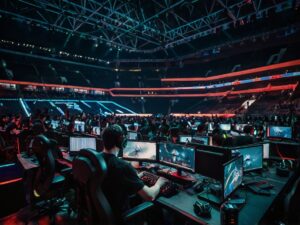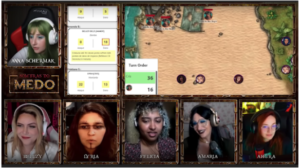This new-found interest, however, seems to have overshadowed some of the earlier research into the exploitation of gaming by jihadist actors conducted over twenty years ago beginning with an interest in jihadist-specific gaming research in the aftermath of the 9/11 attacks. For example, the United States Government 9/11 Commission pointed out how flight simulators and video games were used to increase familiarity with aeroplane models and functions, as well as highlighting security gaps through in-game dynamics. Yet, most of that research corpus is outdated as it focused solely on games themselves and not gamification, recent gaming-adjacent platforms, or gaming aesthetics and gamer types.
This Insight, based on a longer report titled The Gamification of Jihad, seeks to provide an updated analysis of the intersection of gaming and the tactics of extremists on gaming platforms. First, I provide an overview of ‘identity fusion’ between the gaming and extremist space. Second, I outline how accelerationist actors have adopted the tactics of jihadist gamers.
Malleable Identity Fluidity: Understanding Gamers and Extremism
The ability of video games to facilitate training, recruitment and fundraising/money laundering has been an issue of increasing concern among P/CVE practitioners and researchers. Gaming platforms can serve as a fluid intermediate environment fitting for malleable and fluid identity constructs. Here, gamers flow from training to recruitment, from instigation and radicalisation, and back to leisure. These movements are discreet, gamers can flow from one to the other without any clear distinction between gaming and extremist activities.
A previous GNET Insight by Rachel Kowert introduces and discusses the role of identity fusion when analysing gaming and violent extremism. Kowert examines how group and individual identification can merge. This concept of fusion can help dissolve such outdated binary concepts existing between groups and individuals or offline/online domains. In particular, additional research could be taken forward by grouping malleable identities such as gamer types or identities and comparing those with recruitment techniques and motivations for joining violent extremists online (VEOs) when collecting data. For example, Al-Rawi, in his jihadist gaming research, presents the available psychological motivations to join VEOs. As demonstrated in the table below, these groupings compare with Linda Schlegel’s proposed gamer types and identities when working with VEOs and radicalisation.
| Al-Rawi: Who joins VEOs? | Schlegel: Gamer types |
| Revenge Seekers | Disruptors / Competitors / Achievers |
| Status Seekers | Socializers / Meaning Seekers / Competitors / Achievers / Disruptors |
| Identity Seekers | Meaning Seekers / Socializers |
| Thrill Seekers | Competitors / Achievers / Disruptors |
However, in applying identity fusion concepts to the above typologies, we should consider if the ‘group’ and ‘individual’ might actually be more complex. Fusion may not indicate the eradication of all distinctions between each infused partial element of identity. According to Stephanie Taylor and others, “theories of identity construction challenge conventional models of the person as a bounded or monadic individual with a fixed or essential identity, assuming instead a fragmented, incomplete social subject. Identities are presumed to be multiple, complex, and situated.” Fluidity in identity construction is a well-established and used phenomenon, especially when it comes to gaming and gamers in what Muriel and Crawford have described as the ‘video-ludification’ of society into a gamified society.
Accelerationists Developing Jihadist Methodology
Despite the ideological divergence between Jihadists and current right-wing extremists and accelerationism, within the gaming space, we can observe this new generation of extremists drawing on, and learning from the existing tactics established by jihadist actors. The use of first-person shooters (FPS) in VEO propaganda was seen four years before the Christchurch attack in Raqqa, Syria in 2015 at the height of IS-linked propaganda video production and distribution. These included FPS motifs exploited by IS troops fighting Kurdish forces by mounting several GoPros onto fighters’ and snipers’ helmets on the battlefield or alongside a suicide truck driver on his way to reach his target. Providing that gaming-inspired immersiveness and a feeling of ‘being there’, these first-person videos call upon gamified tropes to allow viewers to feel like they are joining the action. Live footage of such attacks was sometimes available online, seconds after a real-world attack. News content is then often reused and edited into more elaborate and longer video productions.
In many ways, the Christchurch, Halle, El Paso, and Buffalo attackers are building upon and advancing a jihadist propaganda methodology by adding a crucial ‘open-air’ live streaming evolution and broadcast approach to their modus operandi. Tactical admiration is shared across ideologies; far-right extremists and neo-Nazis can be envious of and show admiration towards jihadists by copying them. Imitation, as it goes, can be the sincerest form of flattery. Accelerationists may look to Salafi-jihadists and seek to emulate certain victories or attacks of theirs against Western governments and public spaces.
Research by Argentino, Amarasingam and Conley at the International Centre for the Study of Radicalisation (ICSR) has demonstrated how an evolving narrative and aesthetical convergence exists between certain accelerationist and Salafi-jihadist factions. Both subgroups show a cohabitation of digital environments along with an enhanced focus on tactical results over beliefs and ideological practice: a kind of ‘means justifying the end’ attitude. The similarities suggest a sort of cumulative extremism and reciprocal radicalisation or cross-pollination of subcultural aesthetics. These communities also share communicative and symbolic use of violent tactics. For example, although IS pioneered and agitated for vehicle ramming attacks, this is now a common far-right, or Racially and Ethnically Motivated Violent Extremist (REMVE) tactic to target protestors/civilians in peaceful demonstrations.
Logically speaking, racism and Islamophobia would suggest that white nationalists should hate jihadists. REMVE, neo-fascist or accelerationist groups indeed might do so, while simultaneously having a certain amount of begrudged aspirational respect for their counterparts. Jihadists have captured the attention of international media and security agencies around the world. This is a degree of notoriety most REMVE groups have yet to reach, though recent events in the US, Ukraine and Germany are changing this status as of this writing.
The ‘One Struggle’ report concludes with an often-overlooked and compelling convergence: shared recruitment demographics. Both groups recruit in spaces where at-risk youth groups are and engage with pop culture, digital communities and memes rather than in-person forms of human interaction. Recruiters appropriate video game aesthetics in propaganda, demonstrating how accessing key recruitment demographics is likely more important than the misused content itself. With a pragmatic engagement approach that prioritises outreach over content, both have a universal reliance on the internet and use comparable digital recruitment tactics in chat rooms to evade bans, utilising hashtags, memes and gaming spaces.
Conclusion
This Insight has explored two of the significant developments in our understanding of the intersection of gaming and extremism. First, through the concept of identity fusion, researchers are more able to align the categories of radicalisation from P/CVE to gaming. As video game motifs and gamification are applied to other fields, including violent extremism analysis, we should remain aware that fluid, multiple, overlapping and fragmented (gamer) identities are possible. In a society progressively becoming an assemblage of technologically-mediated experiences that connect different realities, situations and cultures, extremist uses of gamer identities are likely layered across many constructs. Further data collection to examine identity formation commonalities – and divergences – between white supremacist and jihadist forms of extremism can help to tease out these layers.
Second, this Insight has outlined how new generations of extremists–namely far-right and accelerationists–are drawing on the tactics and lessons of jihadists. Despite the apparent divergence in ideologies between these groups, cumulative extremism allows for ideological side-switching and fluidity. Both extremist cantons share commonalities in promoting violent extremist tactics, techniques and procedures. Propaganda, myths, martyrs and symbols are closely linked. Therefore, researchers should not discard previous research on jihadist use of gaming platforms but analyse how this knowledge has been used as a base for future extremist groups.
This article was originally published in conjunction with our partner, GNET, as an Insight on 8 February 2023



